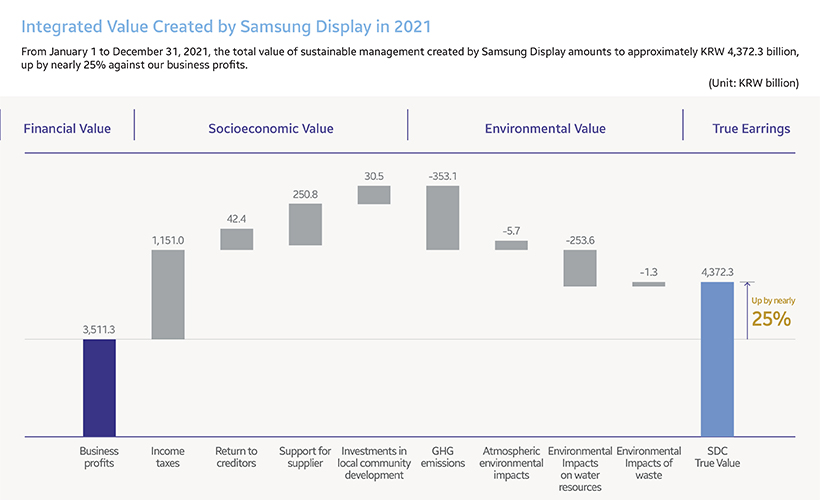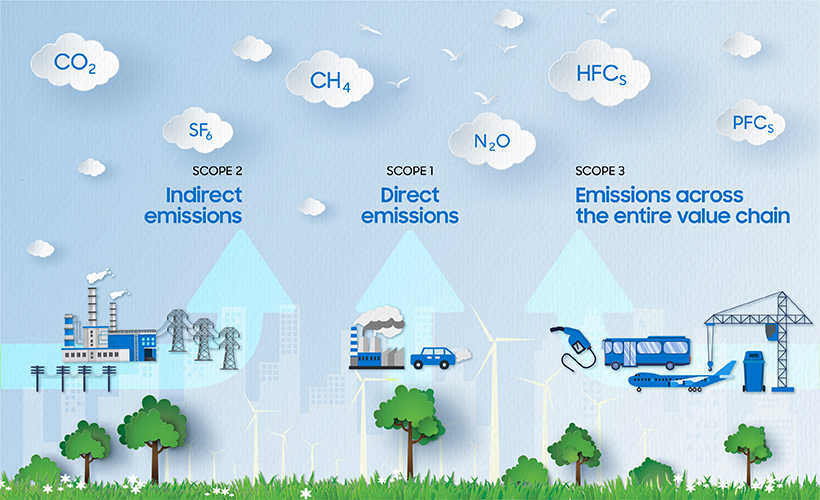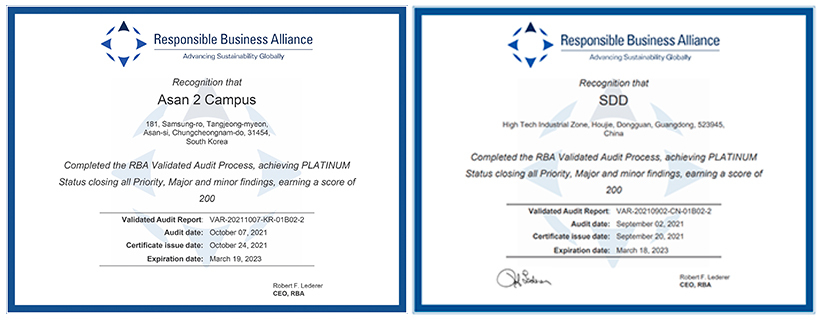
Sustainability Report 2022 Highlights: The Critical Role of ESG Values at Samsung Display
At Samsung Display, our values lie in environmental consciousness as much as in innovative display solutions. We believe that our efforts to display true colors on the screen are only meaningful when we make the world a more sustainable place through our technology.
One of the core values of Samsung Display is to pursue new challenges. Companies in the 21st century are expected by stakeholders to leave the world in a better place for future generations and the communities in which they conduct business.
2021 was the year when we rose to the challenge to meet new demands from both progress and preservation. In February, we joined the Responsible Business Alliance (RBA) to further reinforce ESG values in our management. Throughout the year, Samsung Display earned KRW 4.4 trillion in Integrated Value which is more than a two-fold increase YoY. Based on the KPMG True Value methodology, this value takes into account the earnings from ESG initiatives. It allows us to accurately see what we add to and take from our world. The 2022 Sustainability Report published by Samsung Display is considered a good opportunity to discover its own TRUE COLORS for sustainable values.

Achieving Green Growth with Eco-Friendly Technologies to Preserve the Planet
While unprecedented changes have swept the globe in recent years, companies are confronted with the challenge of solving old problems while still facing new ones.
Amid the deepening climate crisis, Samsung Display has been doing what it does best: rolling out products and technologies that are good for the planet. We have strived to make OLED technology eco-friendly by making the products more energy efficient. Innovations such as Eco²OLED™ reduce power consumption by up to 25 percent on OLED displays. As a result, Samsung Display was able to reduce around 10,000 tons of carbon emissions. Using Samsung’s OLED technology has become an act of environmental conservation.
Samsung Display takes carbon neutrality seriously. Why? Because one-fifth of the world’s carbon emissions come from manufacturing and production sectors, while over half of the world’s energy sources are consumed by production sectors. As in-door activity has become much more commonplace due to the pandemic, experts say the ICT industry could be responsible for up to 14 percent of CO2 emissions by 2040 unless companies take initiative. In 2021, the ICT industry was responsible for 3 to 4 percent of global CO2 emissions.

Analyzing data for emissions is critical for taking steps toward carbon neutrality. Currently, companies classify, manage, and report their carbon emissions using Scopes 1,2 and 3 as defined in the GHG Protocol, which sets global standards for GHG emissions. By incorporating Scope 3 into our ESG evaluation index in 2021, Samsung Display has begun to account for more spheres within the value chain, including sales, delivery, usage and disposal of the product. Scope 1 and 2 account for GHG emissions during product production and those from the energy resource that is used in the production. Samsung Display ensures that our partners are also on board by sponsoring their activities for GHG emissions reduction.
Waste disposal is a critical component within the circular economy, and Samsung Display seeks to minimize the amount of waste so that valuable resources are better managed. In 2021, all four of our production facilities in Korea received “Platinum” status, which is the highest distinction. We are the first company in our respective industry in Korea to receive such recognition for the Zero Waste to Landfill validation.
Last but not least, Samsung Display works to manage air pollutants that occur in industrial sites, especially nitrogen oxides (NOx), which contribute to fine dust formation. We installed De-NOx systems that are designed to cut down the production of the gas. As a result, we were able to reduce the total air pollutants emission to around 50 percent YoY. For branches in China, Samsung Display fully converted their energy source to renewable energy.
Promoting Employee Well-Being and Synergy with Partners

The pandemic has brought into sharp focus social risks, such as those relating to employee wellbeing, health and safety, labor laws, and human rights.
Now more than ever before, health and safety management has become an essential task for companies. Samsung Display established a safety management system for maintaining its history of zero serious accidents, encompassing those at industrial sites and disasters that may be caused throughout the value chain.
When working with partner organizations, Samsung Display has prioritized values of fair trade, mutual growth, carbon neutrality, ESG management and open communication, ensuring commitment to RBA standards.
To strengthen the competitive edge of its partners, Samsung Display has been actively investing in programs for their growth, such as R&D, funds, and education. Since 2018, Samsung Display has been rated Excellent in the “Shared Growth Index evaluation” every year and was selected as the “Best Honorary Company” in 2021.
Diversity and inclusion are one of our top priorities as a leading sustainable technology company. Over the years, Samsung Display has prioritized increasing the number of female employees as well as creating a more inclusive workplace environment for workers with disabilities.
Risk Management for Sustainable Growth
Due to the speed of communication in the internet era, it is more important than ever to respond quickly to internal and external risks surrounding the business environment and to turn crises into opportunities.
Samsung Display analyzes potential risks from different vantage points to ensure sustainable growth of the company. By monitoring risks that exist internally and externally, Samsung Display is equipped to systematically tackle any issues that may arise from economic as well as ESG factors.
By strictly adhering to Samsung Display’s own Global Labor Practice standards, the company strives to prevent violation of the human rights of its employees and abide by labor-related standards of international organizations. The company conducts RBA third-party inspections to set a sustainable and effective response system for due diligence, which has recently risen in importance in the global community. Since 2021, Samsung Display has conducted inspections at four worksites, three of which acquired the RBA Platinum while one worksite acquired the Silver.

Looking Toward a Green Future
In 2021, Samsung Display took diligent steps toward striking the balance between productivity and sustainability, developing technologies that work for the planet, not against it. Our sustainability initiatives will continue to evolve to best address new challenges that are certain to appear as solely focusing on business growth is no longer a company’s primary raison d'être.
The colors we see on our screens will not be nearly as beautiful without the vitality of the natural colors in our environment—and that is why our work in ESG is critical to what we build.
The full text of the 2022 Samsung Display Sustainability Report can be downloaded here.

